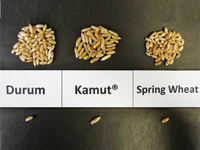
Features
Agronomy
Plant Breeding
Heritage wheat in organic production
In Saskatchewan, heritage wheat varieties are typically grown for
specialty markets and can include hulled wheats (hulls attached) such as
spelt (Triticum aestivum var. spelta), einkorn (T. monococcum) and
emmer (T. dicoccum) or free-threshing wheats such as Red Fife (T.
aestivum) and Khorasan (KAMUT®) wheat (T. turgidum, ssp. turanicum).
February 2, 2012 By Chantal Jacobs Provincial Specialist Organic Crops Saskatchewan Ministry of Agriculture

|
|
| KAMUT wheat, durum and spring wheat comparison.
|
In Saskatchewan, heritage wheat varieties are typically grown for specialty markets and can include hulled wheats (hulls attached) such as spelt (Triticum aestivum var. spelta), einkorn (T. monococcum) and emmer (T. dicoccum) or free-threshing wheats such as Red Fife (T. aestivum) and Khorasan (KAMUT®) wheat (T. turgidum, ssp. turanicum). The majority of these specialty wheat varieties are grown under certified organic production for specific markets.
Organic producers’ interest in heritage wheat varieties has developed based on the belief that heritage wheats provide certain performance advantages under organic conditions compared to wheat varieties selected using conventional breeding programs. Heritage varieties are generally taller, later maturing and have a larger kernel size. They also tend to maintain higher yields in low soil fertility and heavier weed pressure conditions compared to modern wheat varieties.
Spelt is the most commonly grown hulled wheat on the Prairies, with a few thousand acres in production. There are currently four registered spelt varieties available to growers. Spelt tends to be later maturing than spring wheat and often buyers require it to be dehulled, which requires specialized equipment.
Researchers at the University of Saskatchewan continue to work on developing spelt, einkorn and emmer varieties with agronomy and market specifications requested by growers and processors. Currently, einkorn and emmer are grown on minimal acreage in the province.
Free-threshing heritage wheat varieties such as Red Fife and KAMUT are also later maturing varieties grown for specific markets. Red Fife was one of the first wheat varieties grown in Western Canada in the late 1800s and was known for its good milling and baking qualities. It is no longer a registered variety and direct sales are made between producers and end-use markets such as artisan bakeries.
KAMUT is a trademarked wheat variety grown on an estimated 50,000 acres in southern Saskatchewan. It is only grown on contract with two companies in the province (Prairie Heritage Seeds Organics and Artesian Acres), who provide both access to seed in spring and delivery options in the fall. KAMUT wheat grows well in any areas that can grow high-quality durum successfully, and care must be taken to avoid excess damage to the large kernels during threshing and transportation.
In recent years, researchers in Western Canada developed a wheat breeding “proof of concept” program to compare new wheat varieties selected under organic and conventional management. Results showed that the best populations selected under organic management performed better than the top lines developed under conventional management, in organic systems. Based on these results, researchers at the University of Manitoba developed the participatory wheat breeding program. This program works with organic growers to seed small areas with new wheat populations and then actively rogue out poor-performing plants within each plot. Growers will save their seed and continue this process over several years, with the goal of developing genetically diverse wheat varieties that are specifically adapted to their growing region.
Consumer interest in heritage wheat products continues to develop for a number of reasons. They are often described as having a sweet or nutty flavour, and some are noted for having enhanced mineral, carbohydrate or protein characteristics. Consumers with mild wheat allergies can often tolerate products made with these heritage varieties, as the gluten protein tends to be more digestible. However, heritage wheat products still contain gluten and are unsuitable for people affected by celiac disease.